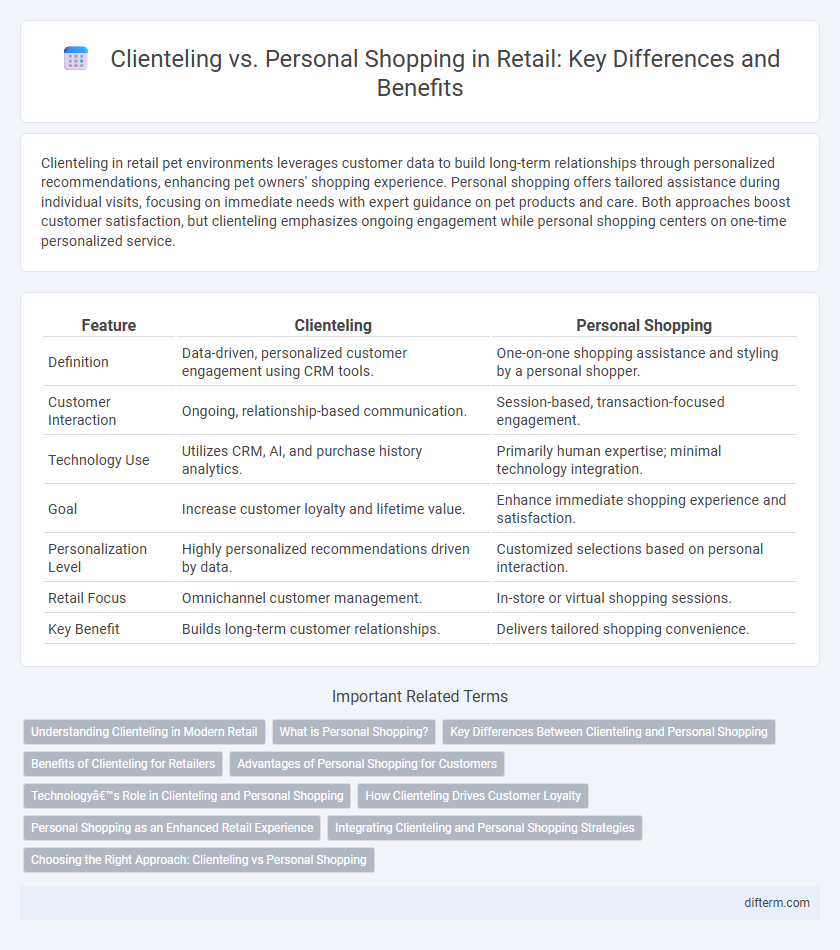Clienteling in retail pet environments leverages customer data to build long-term relationships through personalized recommendations, enhancing pet owners' shopping experience. Personal shopping offers tailored assistance during individual visits, focusing on immediate needs with expert guidance on pet products and care. Both approaches boost customer satisfaction, but clienteling emphasizes ongoing engagement while personal shopping centers on one-time personalized service.
Table of Comparison
| Feature | Clienteling | Personal Shopping |
|---|---|---|
| Definition | Data-driven, personalized customer engagement using CRM tools. | One-on-one shopping assistance and styling by a personal shopper. |
| Customer Interaction | Ongoing, relationship-based communication. | Session-based, transaction-focused engagement. |
| Technology Use | Utilizes CRM, AI, and purchase history analytics. | Primarily human expertise; minimal technology integration. |
| Goal | Increase customer loyalty and lifetime value. | Enhance immediate shopping experience and satisfaction. |
| Personalization Level | Highly personalized recommendations driven by data. | Customized selections based on personal interaction. |
| Retail Focus | Omnichannel customer management. | In-store or virtual shopping sessions. |
| Key Benefit | Builds long-term customer relationships. | Delivers tailored shopping convenience. |
Understanding Clienteling in Modern Retail
Clienteling in modern retail leverages customer data and personalized communication to build long-term relationships and enhance shopping experiences. Unlike personal shopping, which centers on one-time tailoring services, clienteling uses CRM tools to track preferences, purchase history, and engagement across channels. This strategic approach increases customer loyalty, drives repeat sales, and fosters brand affinity in competitive retail environments.
What is Personal Shopping?
Personal shopping in retail involves a tailored approach where a professional assistant helps clients select products based on their preferences, style, and needs. This service enhances customer experience by offering expert advice, saving time, and ensuring satisfaction with personalized recommendations. Unlike general shopping, personal shopping focuses on creating a customized purchasing journey to increase customer loyalty and drive sales.
Key Differences Between Clienteling and Personal Shopping
Clienteling in retail uses customer data and purchase history to build long-term relationships, enabling tailored recommendations and personalized service from store associates. Personal shopping offers immediate, customized assistance primarily for one-time or occasional purchases, focusing on convenience and expert styling. While clienteling emphasizes ongoing engagement and loyalty, personal shopping centers on enhancing the individual shopping experience during specific visits.
Benefits of Clienteling for Retailers
Clienteling enables retailers to build long-term relationships with customers by leveraging personalized data insights and purchase history, resulting in increased customer loyalty and higher lifetime value. By integrating clienteling tools, retailers can provide tailored recommendations and proactive service, enhancing the shopping experience without extensive staff intervention. This approach reduces customer acquisition costs while driving repeat sales and improving overall operational efficiency in retail environments.
Advantages of Personal Shopping for Customers
Personal shopping offers customers tailored experiences by leveraging detailed preferences and purchase history, resulting in highly relevant product recommendations. This personalized attention enhances convenience and efficiency, reducing time spent searching for items while increasing satisfaction. The one-on-one interaction also strengthens trust and builds loyalty through exclusive access to trends and promotions.
Technology’s Role in Clienteling and Personal Shopping
Technology in clienteling leverages customer data analytics, AI-driven recommendations, and CRM integration to deliver personalized shopping experiences that enhance customer loyalty and increase sales. Personal shopping utilizes digital tools such as virtual try-ons and chatbots to provide tailored styling advice and convenience, often through mobile apps and online platforms. Both approaches rely on advanced technologies to create seamless, customized interactions but clienteling emphasizes ongoing relationship building through data-driven insights, while personal shopping focuses on immediate, curated service.
How Clienteling Drives Customer Loyalty
Clienteling leverages detailed customer data and purchase history to create personalized interactions that enhance customer satisfaction and foster long-term loyalty. By providing tailored recommendations and exclusive offers, clienteling builds a deeper emotional connection between the retailer and the customer. Retailers utilizing advanced clienteling platforms experience higher repeat purchase rates and increased customer lifetime value compared to traditional personal shopping methods.
Personal Shopping as an Enhanced Retail Experience
Personal shopping offers a highly personalized retail experience by leveraging customer preferences, purchase history, and style insights to curate tailored product selections. This approach enhances customer satisfaction and loyalty by providing expert guidance and exclusive recommendations that align with individual tastes. Compared to clienteling, personal shopping emphasizes a proactive and immersive interaction that transforms traditional shopping into a customized, memorable journey.
Integrating Clienteling and Personal Shopping Strategies
Integrating clienteling and personal shopping strategies enhances customer experience by combining data-driven insights with personalized service, enabling retailers to tailor product recommendations and communications effectively. Leveraging CRM systems and AI-powered analytics allows for seamless tracking of customer preferences, purchase history, and behavior, fostering long-term loyalty and increased sales. This unified approach optimizes inventory management and targeted marketing, creating a cohesive retail environment that aligns with evolving consumer expectations.
Choosing the Right Approach: Clienteling vs Personal Shopping
Clienteling leverages detailed customer data and purchase history to build long-term relationships and personalized marketing strategies, enhancing customer loyalty in retail. Personal shopping offers immediate, customized assistance through expert stylists or consultants, focusing on real-time needs and preferences for a seamless shopping experience. Selecting between clienteling and personal shopping depends on the retailer's goals: cultivating sustained engagement or providing tailored, on-the-spot service.
Clienteling vs Personal Shopping Infographic

 difterm.com
difterm.com